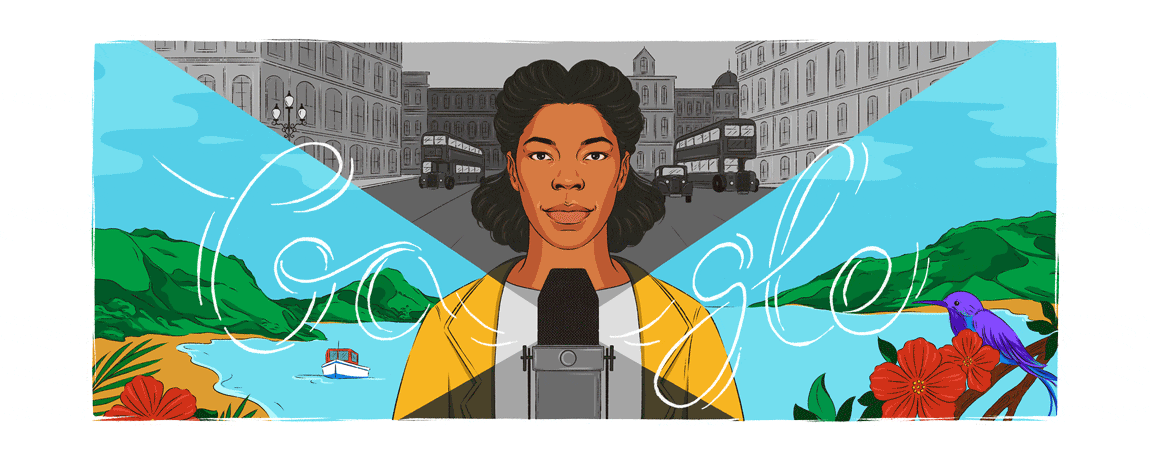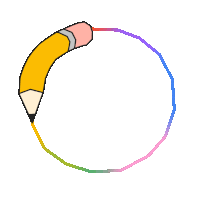
Oct 10, 2021
Celebrating Una Marson
This Doodle’s Key Themes
Today’s Doodle, illustrated by UK-based guest artist Sarah Madden, celebrates one of Jamaica’s most influential feminist thinkers—the writer, advocate, and broadcaster Una Marson. Marson was the first Black woman to be employed as a radio producer at the BBC, where she recorded several significant interviews including one with swing band icon Ken “Snakehips” Johnson, which took place on this day in 1940.
Una Marson was born on February 6, 1905, in Santa Cruz, Jamaica. Marson became Jamaica’s first woman magazine publisher and editor in 1928 when she established “The Cosmopolitan”—a publication focused on gender issues and social injustice. The inspiration she drew from London’s political and literary climate led her to move to the city in 1933. Shocked by the racism she encountered, she started fighting for equal rights alongside fellow Caribbean immigrant Dr. Harold Moody, the founder of civil rights group The League of Coloured Peoples.
Marson returned home in 1936 to cultivate a new generation of Jamaican writers. While writing her own poetry and plays—which she often self-financed—she founded Jamaica’s Save the Children Fund. After relocating again to England in 1938, she took a position at the BBC, where she worked with George Orwell, read her poetry alongside T.S. Eliot, and produced the popular weekly program “Calling the West Indies.” First broadcast in 1943, it featured poems and short stories by Caribbean authors, giving an international platform and voice to writers such as Samuel Selvon. It also publicized both a woman's perspective to the largely male-dominated Black Internationalist Movement and a culturally relevant voice to Britain's growing Caribbean community.
Marson’s literary contributions are not widely known, and even less is known of her later life. However, it was her writing and poetry that influenced the broadcasting she is best known for, and has broadened her legacy for future generations to discover. In 2009, her achievements were celebrated with an installation of a Blue Plaque—which honors individuals who have had great impacts on their community and beyond—at her former home in London’s Brunswick Park.
Here’s to a cultural groundbreaker—thank you Una Marson!
Special thanks to Dr. Delia Jarrett-Macauley—biographer of Una Marson—for her collaboration on this project. Below she shares their thoughts on the Doodle and Una Marson’s legacy.
I’m so proud that Una Marson is being recognised through Sarah Madden’s beautiful Doodle. Una was a significant black female voice of the 20th century, advocating for Jamaica’s women and children and initiating the pioneering BBC programme "Caribbean Voices." I believe she would have been amazed to observe her accomplishments gaining wider recognition—students reading her poetry, companies reviving her plays—and I wish she could have seen this special acknowledgement of her lasting legacy.
Dr. Delia Jarrett-Macauley
Biographer of Una Marson
Huge thanks to the BBC and Robert Seatter, Head of BBC History for their support and contribution. Below he shares his thoughts on the Doodle and Una Marson’s legacy.
Una Marson was a bold and brave pioneering voice in her brief time at the BBC in the 1940s. In producing the popular radio strand "Calling the West Indies," she created the seminal "Caribbean Voices," featuring poems and short stories by Caribbean authors, many of whom were little known at the time. She gave these voices a new and international platform, and the series would continue as her legacy until 1958.
Robert Seatter
Head of BBC History
Copyright BBC
Una Marson joined the BBC full-time in March 1941, when she became a Programme Assistant in the "Empire Programmes" department which created radio broadcasts for English speakers across the British Empire. She quickly became committed to expanding the range of Caribbean voices on air.
Copyright BBC
This extraordinary photograph shows Una Marson literally at the centre of international literary life! She is broadcasting in 1942 as part of Voice, a monthly strand of modern poetry programmes created by George Orwell, then a BBC producer on the BBC Eastern Service (you can see him at the back of the group, to the left). Una is flanked by T.S.Eliot to the left and critic William Empson up right, and writers from India and Sri Lanka (then Ceylon) and other BBC staff members.
Copyright BBC
Learn more about the life and legacy of the pioneering journalist, activist, and poet in a new exhibit
celebrating the life of Una Marson.
Google Arts & Culture in Partnership with the Black Cultural Archives
in collaboration with Connie Bell, Decolonising the Archive
Guest Artist Q&A with Sarah Madden
Today’s Doodle was illustrated by UK-based guest artist Sarah Madden. Below, she shares her thoughts behind the making of this Doodle:
Q. Why was this topic meaningful to you personally?
A. As a woman of Jamaican heritage I feel so much joy and pride to shine a light on and celebrate Una Marson.
Q. What were your first thoughts when you were approached about working on this Doodle?
A. I was very excited to have the opportunity to do a Google Doodle and honoured to illustrate Una Marson.
Q. Did you draw inspiration from anything in particular for this Doodle?
A. Una had many achievements. But this piece was inspired by a legacy she left in the UK broadcasting industry during the war. In 1932, Una travelled from Jamaica to London where she became the first black woman to be employed by the BBC. She then became a producer of the programme Calling the West Indies, where she amplified the voices of unsung West Indian heroes in the UK. The illustration heros Una and depicts her mic as a window to the warm Caribbean from the chilly UK.
Q. What message do you hope people take away from your Doodle?
A. I hope people will learn more about Una Marson and the important role she played in British history. Despite the prejudice and racism she faced, she strived to follow her passions and built a career in journalism, broadcasting, entertainment and writing.
I hope other women can learn about her and be as inspired by her as I am.
Early drafts of the Doodle below
Where this Doodle appeared
Discover more Doodles by color
Did you know?
The very first Doodle launched as an “out of office” message of sorts when company founders Larry and Sergey went on vacation.
Learn MoreDid you know?
The first Doodle launched in 1998, before Google was officially incorporated.
Learn MoreDid you know?
The first same day Doodle was created in 2009 when water was discovered on the moon.
Learn MoreDid you know?
Doodle for Google student contest winners have gone on to become professional artists
Learn MoreDid you know?
The time it takes from sketch to launch for a Doodle varies widely: some have taken years and others just a few hours!
Learn MoreDid you know?
Hundreds of Doodles launch around the world every year. Often, several different ones are live in different places at the same time!
Learn MoreDid you know?
Our most frequently recurring Doodle character is Momo the Cat - named after a real-life team pet!
Learn More